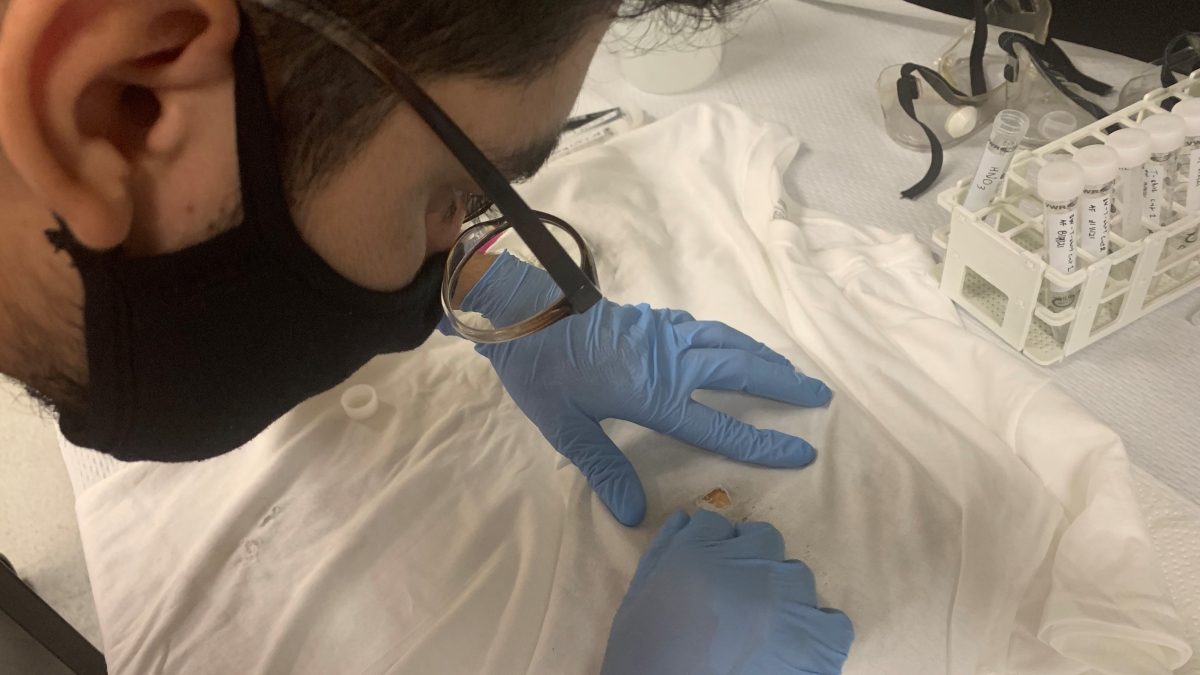Breakthrough chemical analysis links bullets, fragments in shooting investigations

A scientist samples a T-shirt for chemical properties of bullets and the trace evidence left behind. Image courtesy Gwyneth Gordon/ASU
Traditional techniques for analyzing bullets in shooting investigations — such as striae comparison, trajectory analysis and shooting-distance determinations — often face limitations, particularly in complex scenarios involving multiple firearms or moving targets. These methods become even more challenging when projectiles pass through victims or ricochet before or after impact.
Groundbreaking research led by Arizona State University in collaboration with the Mesa Police Department’s Forensic Services unveils a novel technique that explores the chemical associations between bullets, bullet fragments and evidence lifts in order to more definitively associate specific bullets with wound tracks or ricochet marks.
The newly published research in The Association of Firearm and Tool Mark Examiners journal was led by Gwyneth Gordon, assistant research professor at ASU’s School of Earth and Space Exploration, and conducted with the assistance of the Mesa Police Department for their shooting range and long-time shooting investigation expert Luke Haag.
Two decades ago, the National Research Council discredited the practice of associating bullets to a box of bullets using elemental concentrations on scientific grounds. However, Gordon’s research revisits the concept with a modern approach, applying it to a "limited universe" of evidence items at crime scenes and employing advanced analytical techniques, including lead isotope analysis. Shooting investigations often need to determine the exact scenario of a crime, including the positions of the shooter and the victim, as well as the trajectory of multiple fired rounds. Instead of trying to compare a bullet with all possible bullets, comparing trace evidence to bullets fired at a scene allows a more definitive and scientifically supportable answer.
The ASU research team, working with the Mesa Police Department, conducted rigorous tests involving bullets ricocheted off concrete and fired into ballistic gel. Samples from the ricochet marks or bullet fragments left in the gel and the recovered bullets were provided blindly to analysts at ASU. The results demonstrated significant predictive power in correctly associating fragments and ricochet marks with the corresponding bullets, successfully excluding unrelated samples.
“What excited me about this research was it is a gap in forensic investigation proposed by forensic scientists. Conducting research that has immediate practical value in casework is incredibly motivating,” Gordon said.
Co-author and Assistant Professor Shirly Montero in the School of Mathematical and Natural Sciences and the School of Interdisciplinary Forensics shared, "This study is such a good example of the ASU Charter in action given the synergistic intercampus, firearms expert and Mesa Police Department collaboration benefiting the public good. Our results bring back the possibility of using these advanced techniques for a constrained yet useful case context — one of a different nature than the one considered taboo after the FBI discontinued their compositional analysis of bullet lead."
This pioneering study is the first to employ blinded analysis in examining the potential of lead isotopes to assist in shooting investigations. The findings highlight the capability of chemical analysis to enhance the accuracy and reliability of forensic evidence, potentially revolutionizing how shooting incidents are understood and investigated.
This innovative research was conducted in ASU Core Research Facilities. It was supported by the Western Alliance to Expand Student Opportunities (WAESO) program and conducted as part of an undergraduate research project at ASU.
"One thing I love about being staff at (ASU Core Research Facilities) is the ability to support student research as well as my community. (Our) staff have tremendous scientific expertise as well as technical depth,” Gordon said. “The constant exposure to scientific questions from researchers across fields has allowed me to creatively innovate highly interdisciplinary techniques.”
Additional ASU researchers on the paper include WAESO recipient and School of Molecular Sciences alumni Aaron Flores, now a chemical lab technician with Taiwan Semiconductor Manufacturing Company.
More Science and technology

ASU researchers use AI to help people see more clearly
Myopia, also known as nearsightedness, is on the rise, especially among children.Experts predict that by the year 2050, myopia will affect approximately 50% of the world’s population. Researchers…

ASU computer science alum turns entrepreneurship into activism
Tim Cope encourages students to take risks.That may sound like an odd posture for a co-founder of a software firm that helps companies avoid costly business risks — but he has his reasons.“Taking…

Industry leaders give ASU students a look at emerging microtechnology careers
Microelectronics is among the most robust of modern high-tech fields that are becoming integral to progress in many major industries. Its expanding capabilities are enabling advances that promise to…